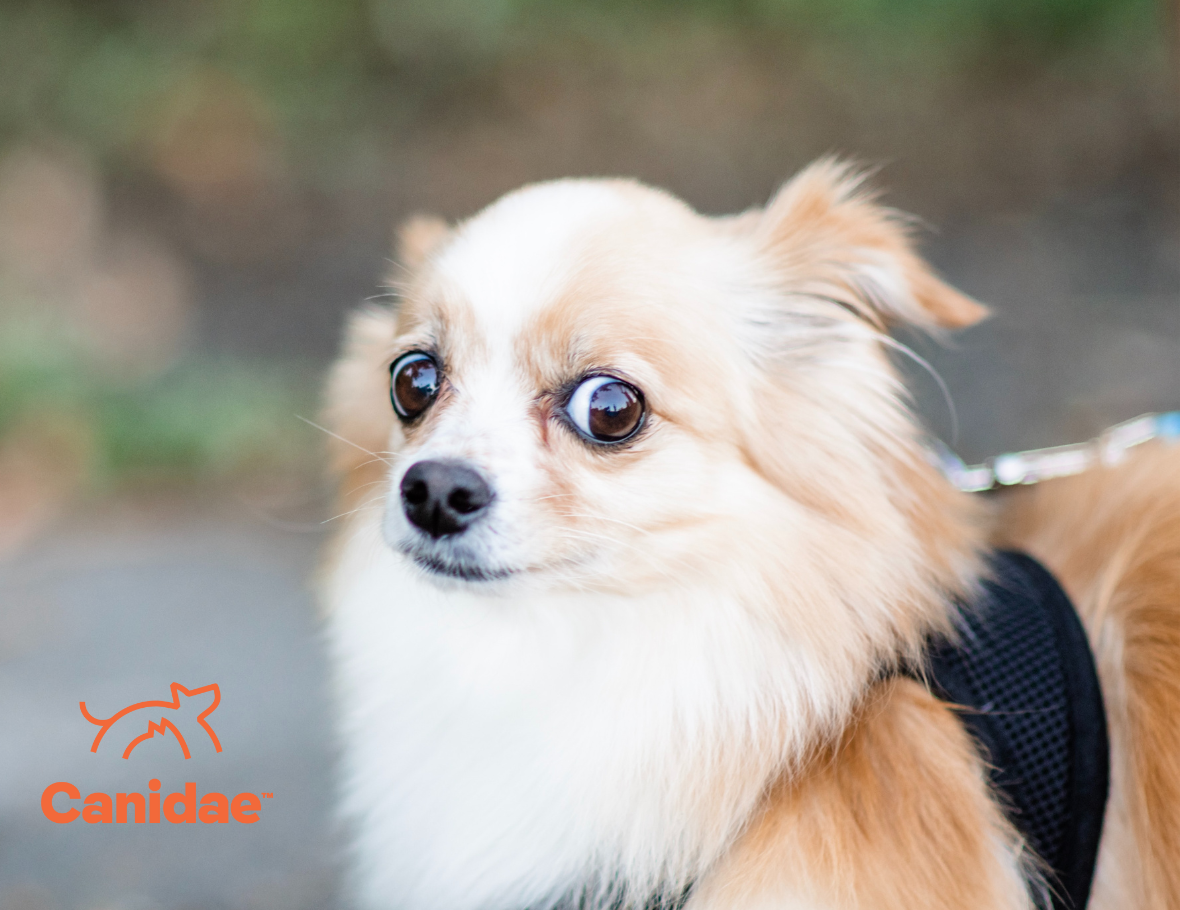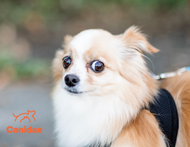Scaredy Dog: How to Help Your Pup Through Dog Fear Periods

Your puppy is confident, playful and social, until one day everything changes. He goes from self-assured to spooked and scared, seemingly overnight. Household appliances and new people suddenly provoke trembles rather than curiosity.
So, what happened? Did the vacuum cleaner suck his soul out and replace it with an evil spirit? Did that tattooed skateboarder hex him with a curse? Don’t worry, it’s nothing that dramatic — you’re just witnessing a dog fear period.
What Are Fear Periods in Dogs?
During a fear period, your pooch may be hyper-sensitive to everything around them, whether that’s people, animals or objects. Remember not to overreact — this is a normal stage of puppy development.
So why do dogs go through these stages? Some believe it’s evolutionary: Before domestication, a dog’s life would be difficult and they would need all the tools they could get to enhance their chances of survival. Fear imprint periods may have given them the chance to prepare themselves for life-threatening situations. For example, if a snake attacked a member of a dog’s pack, this negative experience would provide the impetus to avoid snakes at all costs in the future.
Thankfully your pooch doesn’t have as many life-or-death situations to worry about nowadays. Still, that’s not going to stop him from confusing the rumble of the washing machine with something he should genuinely be scared of.
Fear stages in dogs typically occur at two different times: between 8–11 weeks, and 6–14 months. There’s nothing you can do to prevent these fear periods, but you can give your puppy a helping hand so they come out the other side as a more confident dog.
Fear Period 1: 8–11 Weeks
The first puppy fear period occurs around the time they are typically separated from their mothers before moving to new homes. While the experience of adapting to a new family and location must be nerve-wracking enough, pups also have to cope with their first fear period at the same time.
Make sure you give your puppy enough stimulation, but also be sure to minimize stressful situations. Puppy socialization is important, but don’t pressure your dog into an interaction he’s not comfortable with.
Fear Period 2: 6–14 Months
The second fear period might catch you by surprise, especially if your pup already looks like an adult.
If it feels like the house of cards is tumbling down, try not to worry… your puppy still remembers everything you’ve taught him, he’s just going through a phase. As long as you are calm and considerate while guiding him through this period, that broom isn’t going to give him the heebie-jeebies forever.
It’s worth noting that smaller dogs tend to experience their second fear period earlier than bigger pups. While a Shih Tzu might go through this stage at around 6 months of age, a larger mutt may be closer to 14 months, and something as big as a Great Dane could even start their second fear period at 18 months.
Remember, regardless of size, it can’t be easy to be an adolescent dog adapting to a confusing world. The good news is these stages shouldn’t last too long: Both first and second fear periods typically last between 2–3 weeks.
What Are Dogs Scared of and How Do They Show Fear?
During fear periods, it might seem like your dog is afraid of everything! It really depends on how your dog feels at that moment, but people, objects, animals or even his own reflection can give him a fright.
Different dogs show fear in different ways. Some of the most common fear behaviors include:
- Hiding, freezing in place or running away.
- Aggressive behavior, barking and growling.
- Whining and excessive panting.
- Fearful body language, including having their ears pinned back, tail tucked between their legs, or unexpected urination.
- Facial expressions, such as a closed mouth in a tight grimace, or “whale eye” — the whites of the eyes being very prominent.
How to Help Your Dog Through Fear Periods
Fear periods are sometimes misunderstood as dogs “being difficult,” but the truth is they’re just worried about everything around them. Unfortunately, you can’t tell your dog “it’s just a plastic bag floating in the wind,” so you have to find other ways to calm him. If you feel like a fear period is interfering with your dog training routine, don’t force anything — it’s important to minimize stress during these delicate few weeks.
With regard to attitude, empathy is key. Imagine yourself in your dog’s position. He’s in a relatively new environment that is ruled by tall creatures of another species, when a strange machine appears out of nowhere, before rumbling back and forth and making loud noises as it sucks air deep into its belly. While we know what a vacuum cleaner is, our pets only have instinct to go on.
So, what should you do when your dog is scared of something?
- Stay calm and speak to him in a soothing tone to show him you’re not scared.
- Don’t force him closer to whatever is prompting these emotions.
- Give him space to explore and engage at his own pace.
- Re-direct his attention to something he enjoys like a toy, or distract him by practicing commands like sit, stay and shake.
Some dog owners are tempted to let the fear period pass without exposing their pup to any new stimuli, but this isn’t advisable. During the COVID-19 pandemic, many dogs weren’t able to socialize and vets anticipate this causing problems down the line.
It’s important for dogs to be exposed to new environments, people and other pooches. Still, you should supervise any meetings and avoid any dogs who act unpredictably. It’s also recommendable to avoid on-leash greetings as one bad encounter could provoke future “leash reactivity” — when a dog overreacts to a stimulus when on a leash. Make sure your dog isn’t forced into any stressful environment that could result in him developing long-lasting fears and phobias.
Sometimes a stressful environment is unavoidable, for example, if he needs to visit the veterinary practice. In this case, bring treats and let the vet give them to your pup, as this may help him to break through the fear. Remember the 10% rule: treats should never make up more than 10% of your dog’s daily calorie intake.
If you’re looking for the perfect treat to distract your fearful dog, you can’t go wrong with Canidae® Sustain Jerky Treats: Cage-Free Duck. These delicious bites contain over 75% duck, and with only 5 other ingredients, they’re the perfect simple snack.
You should visit the vet if a fear period lasts longer than 3 weeks or if his fearful behaviors are consistently worsening, but otherwise, you just need to remember not to panic. This could be a great opportunity to help your puppy overcome his fears and to build trust between you.
While you can’t protect your dog from everything, you can provide him with stability in his diet. Canidae PURE Dry PUPPY Food: Salmon and Oatmeal packs premium proteins, healthy fats and wholesome grains in a recipe that contains real salmon as the #1 ingredient. Your pup’s skin, coat and joints will also receive a boost thanks to omega 6 and omega 3 fatty acids, glucosamine and chondroitin.
Think about transitioning your dog to Canidae’s delicious recipes today!

